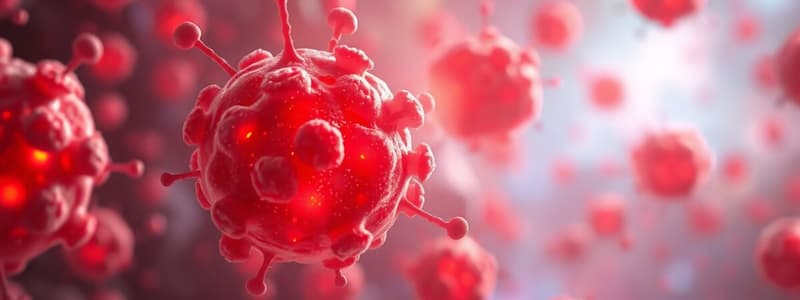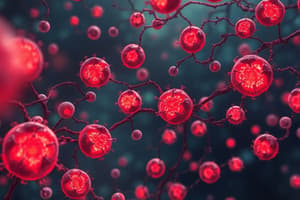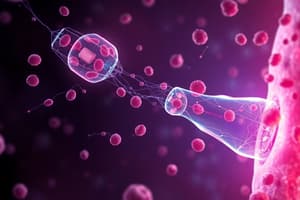Podcast
Questions and Answers
What are chemical mediators responsible for in the body?
What are chemical mediators responsible for in the body?
- Storing nutrients
- Regulating body temperature
- Assisting in inflammatory processes (correct)
- Facilitating oxygen transport
Which of the following is an example of an exogenous chemical mediator?
Which of the following is an example of an exogenous chemical mediator?
- Histamine
- Leukocytes
- E. coli (correct)
- Fibroblasts
Which cell type is primarily responsible for producing endogenous chemical mediators at the site of inflammation?
Which cell type is primarily responsible for producing endogenous chemical mediators at the site of inflammation?
- Adipocytes
- Hepatocytes
- Endothelial cells (correct)
- Myocytes
What type of chemical mediators are synthesized by the liver?
What type of chemical mediators are synthesized by the liver?
What is the role of the complement system in inflammation?
What is the role of the complement system in inflammation?
Which of the following statements about chemical mediators is correct?
Which of the following statements about chemical mediators is correct?
The release of exogenous chemical mediators leads to what effect at the venule site?
The release of exogenous chemical mediators leads to what effect at the venule site?
What is the primary function of phagocytotic cells?
What is the primary function of phagocytotic cells?
Which type of phagocytic cell is primarily associated with early acute inflammation?
Which type of phagocytic cell is primarily associated with early acute inflammation?
What is Opsonization?
What is Opsonization?
What role do IgG and C3b play in phagocytosis?
What role do IgG and C3b play in phagocytosis?
Which step in phagocytosis involves the formation of a phagosome?
Which step in phagocytosis involves the formation of a phagosome?
What happens during the degradation and killing step of phagocytosis?
What happens during the degradation and killing step of phagocytosis?
Which cells are known as macrophages?
Which cells are known as macrophages?
How long are PMNs typically present during inflammation?
How long are PMNs typically present during inflammation?
What is the role of phagolysosomes?
What is the role of phagolysosomes?
Which of the following correctly describes macrophages?
Which of the following correctly describes macrophages?
What is the primary mechanism of phagocytosis that significantly increases oxygen consumption?
What is the primary mechanism of phagocytosis that significantly increases oxygen consumption?
Which enzyme is responsible for producing oxygen metabolites during the oxygen-dependent mechanism?
Which enzyme is responsible for producing oxygen metabolites during the oxygen-dependent mechanism?
Which of the following contributes to the oxygen-independent mechanism?
Which of the following contributes to the oxygen-independent mechanism?
What is the role of myeloperoxidase in phagocytosis?
What is the role of myeloperoxidase in phagocytosis?
The low pH within the phagolysosome primarily affects microbial growth how?
The low pH within the phagolysosome primarily affects microbial growth how?
Which protein is NOT associated with the oxygen-independent mechanism?
Which protein is NOT associated with the oxygen-independent mechanism?
During phagocytosis, what is formed when a phagosome fuses with a lysosome?
During phagocytosis, what is formed when a phagosome fuses with a lysosome?
Which of the following is a product of the oxygen-dependent mechanism?
Which of the following is a product of the oxygen-dependent mechanism?
What is the primary role of PECAM-1 in leukocyte transmigration?
What is the primary role of PECAM-1 in leukocyte transmigration?
Which process describes the release of digested material from the phagocyte after phagocytosis?
Which process describes the release of digested material from the phagocyte after phagocytosis?
Which mechanism of phagocytosis is considered more effective?
Which mechanism of phagocytosis is considered more effective?
Which of the following represents a step involved in the process of leukocyte transmigration?
Which of the following represents a step involved in the process of leukocyte transmigration?
What type of factors are primarily responsible for directing leukocyte movement towards an inflammation site?
What type of factors are primarily responsible for directing leukocyte movement towards an inflammation site?
Which of the following is NOT considered an endogenous chemotactic factor?
Which of the following is NOT considered an endogenous chemotactic factor?
What is the main function of leukotriene B4 (LTB4) in the context of leukocyte behavior?
What is the main function of leukotriene B4 (LTB4) in the context of leukocyte behavior?
What describes the process of margination in leukocyte behavior?
What describes the process of margination in leukocyte behavior?
Which of the following correctly describes chemotaxis?
Which of the following correctly describes chemotaxis?
What role do selectins play in leukocyte physiology?
What role do selectins play in leukocyte physiology?
Which complement component is especially known for its chemotactic properties for leukocytes?
Which complement component is especially known for its chemotactic properties for leukocytes?
What is the sequence of steps in leukocyte movement across the endothelium?
What is the sequence of steps in leukocyte movement across the endothelium?
What physiological change initiates the process of margination during inflammation?
What physiological change initiates the process of margination during inflammation?
Which process follows the margination of leukocytes in the emigration steps?
Which process follows the margination of leukocytes in the emigration steps?
What role do E-selectins play in the rolling phase of leukocyte emigration?
What role do E-selectins play in the rolling phase of leukocyte emigration?
What is the final step in the emigration process of leukocytes through the endothelial barrier?
What is the final step in the emigration process of leukocytes through the endothelial barrier?
During inflammation, what effect does stasis have on the flow of leukocytes?
During inflammation, what effect does stasis have on the flow of leukocytes?
What characterizes normal blood flow within blood vessels?
What characterizes normal blood flow within blood vessels?
What is the primary consequence of increased plasma viscosity during an inflammatory response?
What is the primary consequence of increased plasma viscosity during an inflammatory response?
Which of the following best defines diapedesis in leukocyte emigration?
Which of the following best defines diapedesis in leukocyte emigration?
Flashcards
Margination
Margination
Leukocytes accumulating along blood vessel endothelium during inflammation.
Rolling leukocytes
Rolling leukocytes
Leukocytes loosely attach to endothelium, following margination, before adhesion, mediated by E-selectins.
Adhesion
Adhesion
Leukocytes firmly attaching to endothelial cells.
Diapedesis
Diapedesis
Signup and view all the flashcards
E-selectins
E-selectins
Signup and view all the flashcards
Inflammation
Inflammation
Signup and view all the flashcards
Laminar flow
Laminar flow
Signup and view all the flashcards
Leukocytes
Leukocytes
Signup and view all the flashcards
Leukocyte Transmigration
Leukocyte Transmigration
Signup and view all the flashcards
Chemotaxis
Chemotaxis
Signup and view all the flashcards
Chemotactic Agent (Exogenous)
Chemotactic Agent (Exogenous)
Signup and view all the flashcards
Chemotactic Agent (Endogenous)
Chemotactic Agent (Endogenous)
Signup and view all the flashcards
Cytokines (Chemokines)
Cytokines (Chemokines)
Signup and view all the flashcards
PECAM-1
PECAM-1
Signup and view all the flashcards
Leukotriene B4 (LTB4)
Leukotriene B4 (LTB4)
Signup and view all the flashcards
Complement C5a
Complement C5a
Signup and view all the flashcards
Diapedesis
Diapedesis
Signup and view all the flashcards
Inflammatory Site
Inflammatory Site
Signup and view all the flashcards
Phagocytosis Definition
Phagocytosis Definition
Signup and view all the flashcards
Phagocytic Cells Type 1
Phagocytic Cells Type 1
Signup and view all the flashcards
Phagocytic Cells Type 2
Phagocytic Cells Type 2
Signup and view all the flashcards
Opsonization
Opsonization
Signup and view all the flashcards
Opsonins (IgG & C3b)
Opsonins (IgG & C3b)
Signup and view all the flashcards
Phagosome Formation
Phagosome Formation
Signup and view all the flashcards
Phagolysosome
Phagolysosome
Signup and view all the flashcards
Phagocytosis Step 1
Phagocytosis Step 1
Signup and view all the flashcards
Phagocytosis Step 2
Phagocytosis Step 2
Signup and view all the flashcards
Phagocytosis Step 3
Phagocytosis Step 3
Signup and view all the flashcards
Chemical Mediators
Chemical Mediators
Signup and view all the flashcards
Exogenous Mediators
Exogenous Mediators
Signup and view all the flashcards
Endogenous Mediators
Endogenous Mediators
Signup and view all the flashcards
Cell-Derived Mediators
Cell-Derived Mediators
Signup and view all the flashcards
Circulating Plasma Proteins
Circulating Plasma Proteins
Signup and view all the flashcards
Vascular Phenomena
Vascular Phenomena
Signup and view all the flashcards
Inflammatory Response
Inflammatory Response
Signup and view all the flashcards
Phagocytosis
Phagocytosis
Signup and view all the flashcards
Oxygen-dependent Mechanism
Oxygen-dependent Mechanism
Signup and view all the flashcards
Phagolysosome
Phagolysosome
Signup and view all the flashcards
NADPH oxidase
NADPH oxidase
Signup and view all the flashcards
Oxygen metabolites
Oxygen metabolites
Signup and view all the flashcards
Myeloperoxidase
Myeloperoxidase
Signup and view all the flashcards
Oxygen-independent Mechanism
Oxygen-independent Mechanism
Signup and view all the flashcards
Lysozyme
Lysozyme
Signup and view all the flashcards
Phagosome
Phagosome
Signup and view all the flashcards
Lysosome
Lysosome
Signup and view all the flashcards
Study Notes
B-Cellular Events
- A group of sequential processes results in formation of cellular exudation & destroy the injurious agent.
- Normal blood flow in lumen of blood vessels, the cellular elements → flow in the center of the vessel → laminar flow, plasma is flowing adjacent to endothelium, with stasis during inflammation Leukocytes accumulate at the periphery of vessel along the endothelium (process called Margination)
I. Emigration of Leukocytes
- Divided into 4 steps
- 1. Margination: Increased plasma viscosity due to loss of intravascular fluid → Decreased blood flow → White blood cells fall out of axial stream into plasmatic zone
- 2. Rolling: Is mediated by the action of E-selectins which bind endothelial cells loosely to leukocytes producing a characteristic rolling movement of leukocytes along the endothelial surface.
- 3. Adhesion: Leukocytes adhere to the endothelial surface through the
- 4. Diapedesis (trans-migration across the endothelium):
Studying That Suits You
Use AI to generate personalized quizzes and flashcards to suit your learning preferences.




